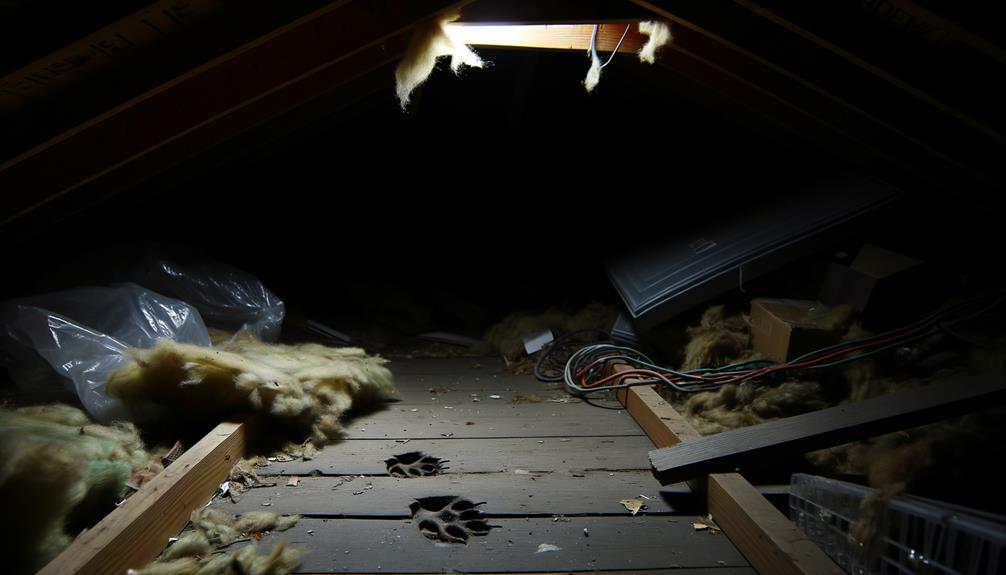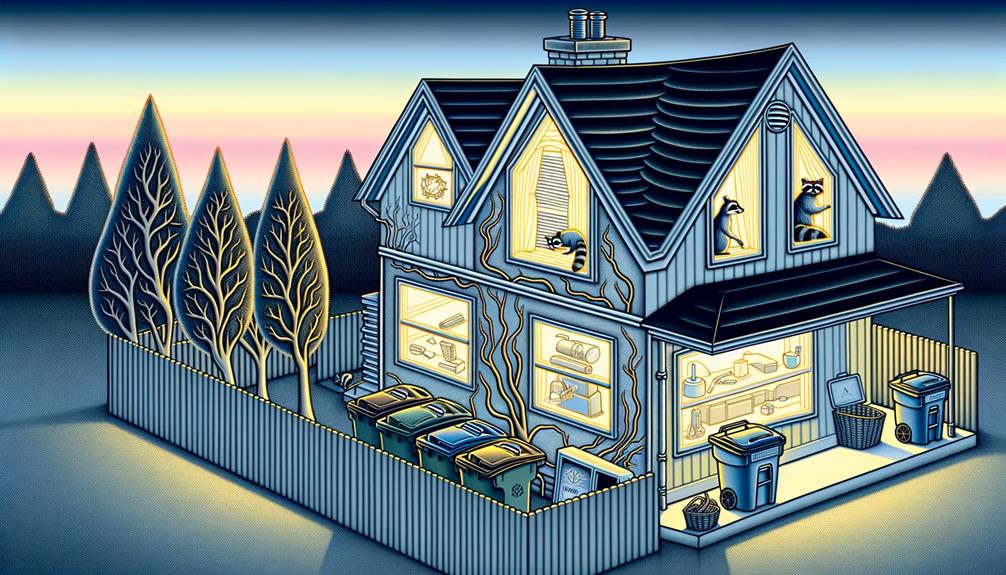How Do Raccoons Live in Attics?
Raccoons often inhabit attics due to the warmth and safety these spaces provide. The elevated environment helps them avoid predators and harsh weather, while insulation guarantees a consistent temperature ideal for nesting.
Attics are also less disturbed by human activity, making them a quiet refuge for raising young. Common signs of raccoon infestation include nocturnal noises, droppings, and structural damage.
Immediate action is essential as raccoons pose risks like disease transmission and fire hazards. Understanding why raccoons choose attics and how to address the issue can protect both your property and health.
Discover more effective removal and prevention methods next.

Key Takeaways
- Raccoons seek attics for warmth, safety, and proximity to food sources.
- Elevated attic spaces help raccoons avoid predators and harsh weather.
- Nocturnal noises and structural damage can indicate raccoon presence in attics.
- Raccoons in attics pose health risks due to potential diseases and parasites.
- Humane removal and prevention methods are essential for addressing raccoon infestations.
Why Raccoons Choose Attics

Raccoons often choose attics for shelter due to their warmth, safety, and proximity to food sources. These environments provide a secure, elevated space that helps raccoons avoid predators and harsh weather conditions. The insulation in attics offers a consistent temperature, making it an ideal location for nesting, especially during colder months.
Additionally, attics are typically less disturbed by human activity, offering a quiet refuge for raccoons to raise their young. Proximity to urban and suburban areas means easy access to food sources, such as garbage bins, pet food, and gardens. The combination of these factors makes attics an attractive option for raccoons seeking a sheltered and resource-rich habitat.
Understanding these reasons helps in addressing the presence of raccoons effectively.
Signs of Raccoon Infestation
Identifying a raccoon infestation in an attic often begins with noticing nocturnal noises such as thumping or scratching.
Additionally, the presence of raccoon droppings and visible structural damage, including torn insulation or chewed wires, can serve as key indicators.
Recognizing these signs early is vital for addressing the problem promptly and effectively.
Nocturnal Noises Heard
One of the most telling signs of a raccoon infestation in the attic is the presence of unusual nocturnal noises. Typically active during the night, raccoons often produce a variety of sounds, including thumping, scratching, and chittering. These noises are usually most pronounced during the evening and early morning hours when the animals are most active.
Homeowners may also hear the sounds of raccoons moving around, particularly if they are foraging for food or creating nests. The distinctiveness of these sounds, coupled with their timing, can be a strong indicator of raccoon activity.
Prompt attention to these auditory signs is essential for addressing potential infestations effectively and preventing further complications within the home.
Droppings and Damage
Among the most evident indicators of a raccoon infestation in the attic are the presence of droppings and structural damage. Raccoon droppings are typically dark, tubular, and can measure up to three inches in length. These fecal deposits can accumulate, posing health risks due to the potential presence of pathogens like roundworm.
Structural damage often includes torn insulation, chewed wiring, and shredded ductwork. Raccoons may also cause roof damage by prying up shingles or gnawing through soffits to gain entry. Additionally, gnaw marks on wooden beams and claw marks around entry points are common.
Identifying these signs early is essential for mitigating further damage and addressing potential health hazards posed by raccoon infestations.
Risks of Raccoons in Attics

The presence of raccoons in attics poses significant risks to both property and health. Structurally, raccoons can cause extensive damage by tearing insulation, chewing electrical wires, and compromising the integrity of roofs and walls. Such destruction may lead to costly repairs and potential fire hazards due to exposed wiring.
Health risks are also paramount, as raccoons are carriers of various diseases, including rabies and leptospirosis, which can be transmitted to humans and pets. Their droppings may harbor parasites like roundworms, posing further health concerns. Additionally, raccoons may create unsanitary conditions through urine and feces accumulation, attracting insects and other pests.
Addressing these risks promptly is essential for safeguarding both the home and its inhabitants.
Humane Raccoon Removal Methods
Humane raccoon removal methods are essential to guarantee the safety and well-being of both the animals and homeowners.
These methods include live trapping techniques, the use of exclusion devices, and the benefits of seeking professional assistance.
Each approach provides a responsible solution to address raccoon infestations effectively.
Live Trapping Techniques
Implementing live trapping techniques involves careful planning and adherence to ethical guidelines to guarantee the humane removal of raccoons from attics.
To start, selecting the appropriate trap size is vital to ensure the animal's comfort and safety. Baiting the trap with food that raccoons find irresistible, such as marshmallows or cat food, increases success rates.
It's important to monitor traps frequently to minimize stress and potential injury to the captured raccoon. Once trapped, the raccoon should be relocated to a suitable habitat far from residential areas to prevent re-entry.
Adhering to local wildlife regulations is essential throughout the process. Utilizing these methods helps in achieving a humane and effective solution to raccoon infestations in attics.
Exclusion Devices Usage
Utilizing exclusion tools offers a non-invasive and humane approach to prevent raccoons from re-entering attics after removal. These tools, such as one-way passages and exclusion channels, allow raccoons to exit but block their re-entry. Proper installation is essential and typically involves identifying and sealing all potential entry points, except for one primary exit equipped with the tool. This method guarantees that the raccoons vacate the premises without harm and are unable to return.
Exclusion tools are especially effective when combined with habitat modification techniques, such as trimming overhanging branches and securing garbage bins. This inclusive approach minimizes the likelihood of future infestations, promoting a harmonious coexistence between humans and wildlife.
Professional Assistance Benefits
While exclusion devices are effective, enlisting professional assistance offers extra benefits for guaranteeing humane raccoon removal. Professionals are trained to handle wildlife with care, utilizing techniques that prioritize the well-being of the animals. They can accurately assess the situation, identify all entry points, and implement thorough exclusion strategies to prevent future invasions.
Additionally, experts possess the necessary equipment to safely capture and relocate raccoons, adhering to local wildlife regulations. Their expertise minimizes the risk of injury to both the animals and the property owners.
Moreover, professionals often provide follow-up inspections and advice on raccoon-proofing your home, offering a long-term solution to potential infestations. This all-encompassing approach ensures a humane, effective resolution to raccoon problems in attics.
Preventing Future Infestations

To effectively prevent future infestations of raccoons in attics, it is essential to seal all potential entry points and maintain the structural integrity of the building. Begin by inspecting the attic, roof, and exterior walls for gaps, holes, or weak spots.
Use durable materials such as metal flashing or heavy-gauge mesh to cover vents, chimneys, and any openings larger than half an inch. Additionally, trim tree branches that extend close to the roof, as raccoons often use these as access points.
Regular maintenance and timely repairs are critical to ensuring that new entry points do not develop. Implementing these preventive measures will considerably reduce the likelihood of raccoon infestations, safeguarding both your property and its occupants.
Repairing Raccoon Damage
Addressing the damage caused by raccoons is essential for restoring the safety and functionality of your attic. Raccoons often cause significant harm to insulation, wiring, and structural components.
Begin by thoroughly inspecting the area for chewed wires, which pose a fire hazard. Replace any damaged insulation to maintain energy efficiency and prevent mold growth. Repair structural damage to beams or rafters, ensuring the integrity of the roof.
Additionally, clean and disinfect the area to mitigate health risks from raccoon feces and urine. Utilize professional pest control services for a thorough assessment and repair plan.
Swift and meticulous attention to these repairs will safeguard your home and prevent future issues related to raccoon intrusions.
Conclusion
Essentially, the raccoon's intrusion into attics serves as a modern-day parable, symbolizing the delicate balance between nature and human habitation.
Recognizing the signs of their presence, understanding the inherent risks, and employing humane removal methods are crucial steps in maintaining this equilibrium.
Preventative measures and diligent repair of any damage further guarantee that homes remain sanctuaries free from these nocturnal invaders, reflecting a broader commitment to coexisting responsibly with the natural world.






